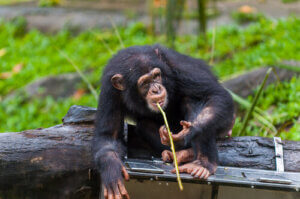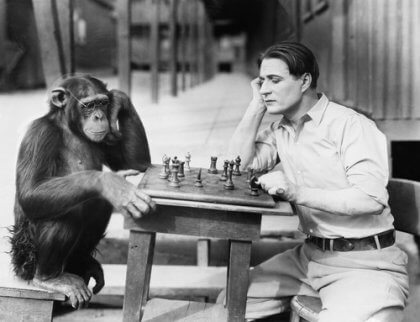Culture in Animals


Written and verified by the vet Eugenio Fernández Suárez
We live in an anthropocentric society, in which human beings aren’t just the center of everything, but also the measure of everything. This means that throughout history we’ve looked down on animals. Today, we’re going to talk about culture in animals.
Humans aren’t unique
Even though we’re different from animals, there are still many similarities between us. This is demonstrated every time we think a characteristic is exclusively human, and turns out not to be.
An example of this is using tools: 50 years ago, human beings were defined by their ability to make and use tools, until Jane Goodall discovered that chimpanzees could do it as well. When Goodall called her mentor, Louis Leakey, she was told that they could change the definition of man or start calling chimpanzees humans.
What is culture?
This is just one example of the many occasions in which a characteristic that was originally considered to be exclusive to humans turned out to be something that we share with other living beings. Culture in animals is another example of this.
Culture can be defined as certain knowledge and behavior belonging to a social group, handed down from generation to generation. However, it’s not necessarily behavior that’s shared by the entire species. Instead, it’s behavior that the same group within a region shares.
Culture in animals: non-human primates
Many animals possess this concept of culture. One of the first cases was likely in a study of Japanese macaques, which showed differentiated behaviors. Some macaques, which lived on the beach, cleaned their potatoes in the seawater, while others didn’t.

While most cases of culture in animals don’t match the complexity of human culture, many are surprising. People have studied chimpanzee culture extensively. These studies show that some groups hunt with sticks, while others use leaves to drink or stones to crack nuts.
Although this is an example of animals using tools, what’s surprising is that different chimpanzee populations make different uses of these objects. Therefore, it’s an example of culture in animals.
Culture in animals: cetaceans
Marine mammals, particularly cetaceans, are another group of animals that we have studied and where we have undoubtedly seen culture in animals. Orcas, dolphins, whales, and porpoises are animals with surprising behavior and whose behavior has a huge cultural component.
A clear example are orcas. We aren’t currently clear on whether there’s more than one species of orca. Because of that, they’re classified according to their different ecotypes. This is because different groups of killer whales on the planet have different behavior.
Killer whales and their groups can be organized in different ways. Surprisingly, between different groups of orcas there are different dialects, as if they had different languages. This is similar to humans because we all use speech to communicate, but we do so using different languages.
Another example of culture in animals, and specifically in killer whales, is their hunting techniques. For example, some killer whales go to the beach to hunt for seals, while others submerge sheets of ice or stun banks of fish.

Another great example is dolphins: some of these animals have collaborated with humans who are fishing. However, that’s only the case in some places. These animals attract fish to the nets and signal fisherman when to cast their lines. In return, the fishermen reward the dolphins.
Culture in animals, still unexplored
In addition to primates, other mammals have proven to be examples of culture in animals. For example, Joseph Terkel discovered how black rats teach each other to peel pineapple and eat it. This is something that rats pass down through different generations.
In addition, certain birds have shown cultural behavior. Starlings appear to have regional dialects and have different flight patterns. In general, there are quite a few distinctive dialects in many bird species, like thrushes and sparrows.
The truth is that there are hundreds of species with surprising cultural behavior. In this article, we weren’t able to talk about all of them, like the cultural behavior of parrots or elephants. However, what’s clear is that there are still many surprising behavior patterns that we need to discover in the animal world. With each discovery, we remind ourselves that we’re not as unique or special as we thought.
We live in an anthropocentric society, in which human beings aren’t just the center of everything, but also the measure of everything. This means that throughout history we’ve looked down on animals. Today, we’re going to talk about culture in animals.
Humans aren’t unique
Even though we’re different from animals, there are still many similarities between us. This is demonstrated every time we think a characteristic is exclusively human, and turns out not to be.
An example of this is using tools: 50 years ago, human beings were defined by their ability to make and use tools, until Jane Goodall discovered that chimpanzees could do it as well. When Goodall called her mentor, Louis Leakey, she was told that they could change the definition of man or start calling chimpanzees humans.
What is culture?
This is just one example of the many occasions in which a characteristic that was originally considered to be exclusive to humans turned out to be something that we share with other living beings. Culture in animals is another example of this.
Culture can be defined as certain knowledge and behavior belonging to a social group, handed down from generation to generation. However, it’s not necessarily behavior that’s shared by the entire species. Instead, it’s behavior that the same group within a region shares.
Culture in animals: non-human primates
Many animals possess this concept of culture. One of the first cases was likely in a study of Japanese macaques, which showed differentiated behaviors. Some macaques, which lived on the beach, cleaned their potatoes in the seawater, while others didn’t.

While most cases of culture in animals don’t match the complexity of human culture, many are surprising. People have studied chimpanzee culture extensively. These studies show that some groups hunt with sticks, while others use leaves to drink or stones to crack nuts.
Although this is an example of animals using tools, what’s surprising is that different chimpanzee populations make different uses of these objects. Therefore, it’s an example of culture in animals.
Culture in animals: cetaceans
Marine mammals, particularly cetaceans, are another group of animals that we have studied and where we have undoubtedly seen culture in animals. Orcas, dolphins, whales, and porpoises are animals with surprising behavior and whose behavior has a huge cultural component.
A clear example are orcas. We aren’t currently clear on whether there’s more than one species of orca. Because of that, they’re classified according to their different ecotypes. This is because different groups of killer whales on the planet have different behavior.
Killer whales and their groups can be organized in different ways. Surprisingly, between different groups of orcas there are different dialects, as if they had different languages. This is similar to humans because we all use speech to communicate, but we do so using different languages.
Another example of culture in animals, and specifically in killer whales, is their hunting techniques. For example, some killer whales go to the beach to hunt for seals, while others submerge sheets of ice or stun banks of fish.

Another great example is dolphins: some of these animals have collaborated with humans who are fishing. However, that’s only the case in some places. These animals attract fish to the nets and signal fisherman when to cast their lines. In return, the fishermen reward the dolphins.
Culture in animals, still unexplored
In addition to primates, other mammals have proven to be examples of culture in animals. For example, Joseph Terkel discovered how black rats teach each other to peel pineapple and eat it. This is something that rats pass down through different generations.
In addition, certain birds have shown cultural behavior. Starlings appear to have regional dialects and have different flight patterns. In general, there are quite a few distinctive dialects in many bird species, like thrushes and sparrows.
The truth is that there are hundreds of species with surprising cultural behavior. In this article, we weren’t able to talk about all of them, like the cultural behavior of parrots or elephants. However, what’s clear is that there are still many surprising behavior patterns that we need to discover in the animal world. With each discovery, we remind ourselves that we’re not as unique or special as we thought.
This text is provided for informational purposes only and does not replace consultation with a professional. If in doubt, consult your specialist.








